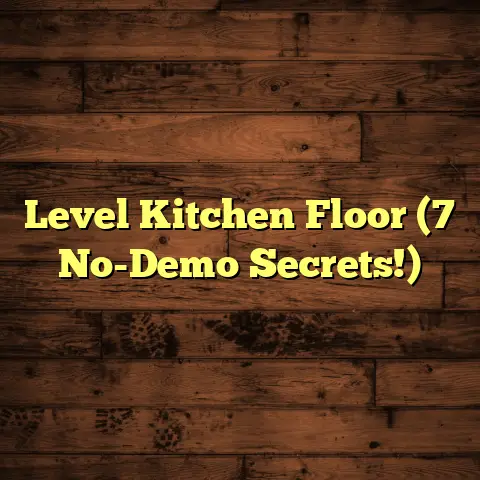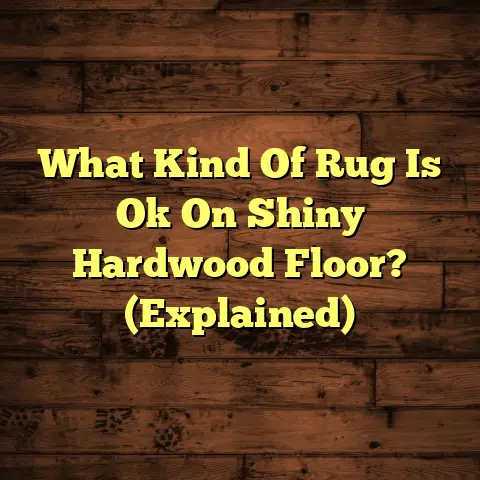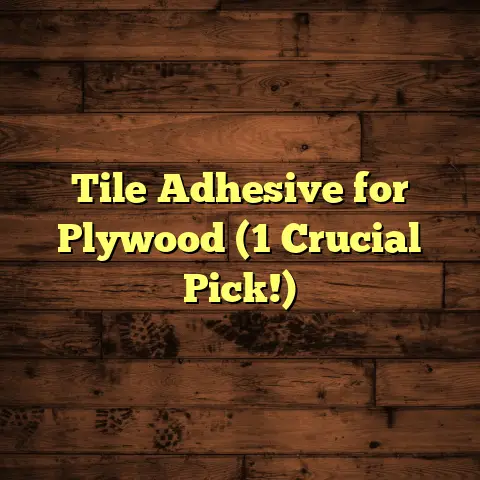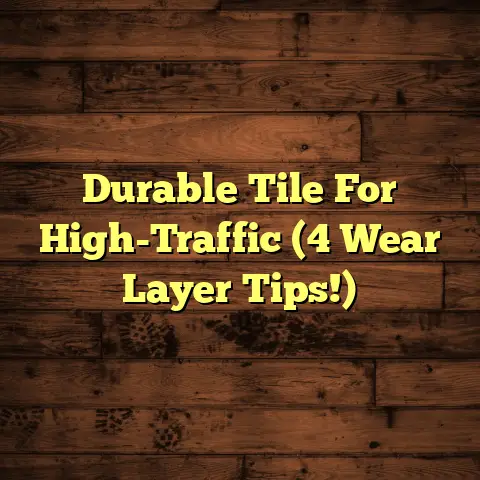How To Clean Floors: No Stick! (5 Pro Secrets)
Did you know the average household floor can harbor over 200,000 bacteria per square inch? That’s right! It’s one of the dirtiest surfaces in your home. Yikes! Makes you want to grab a mop, doesn’t it?
I’ve seen it all in my years as a flooring contractor. From sticky residues that just won’t budge to grime buildup that seems impossible to conquer.
Let’s face it, cleaning floors can be a real pain. But a clean floor isn’t just about looks; it’s about the health and safety of your family. So, how do you get that spotless, no-stick finish?
Well, stick around (pun intended!), because I’m about to share my top 5 pro secrets to help you achieve flooring nirvana. Let’s dive in!
Understanding Different Floor Types
Okay, first things first: not all floors are created equal. You wouldn’t use the same shampoo on a poodle as you would on a horse, would you? Same goes for floors!
Here’s a quick rundown:
-
Hardwood: Beautiful, classic, but sensitive to water.
-
Laminate: Durable, budget-friendly, but can be slippery.
-
Tile: Tough, water-resistant, but grout can be a nightmare.
-
Vinyl: Versatile, easy to clean, but can scratch easily.
Each type has its own quirks. Hardwood hates excessive moisture, while tile grout loves to trap dirt. Laminate can get sticky if you use the wrong cleaner, and vinyl can show every little scratch if you’re not careful.
Think of it this way: hardwood is like that high-maintenance friend who needs constant attention, while vinyl is the easygoing pal who’s always up for anything.
Here’s a table showing how each floor type reacts to different cleaning agents:
| Floor Type | Best Cleaning Agents | Worst Cleaning Agents |
|---|---|---|
| Hardwood | pH-balanced wood cleaner, mild soap | Excessive water, harsh chemicals, vinegar |
| Laminate | Laminate floor cleaner, mild soap | Abrasive cleaners, steam mops (excessive moisture) |
| Tile | Tile cleaner, bleach solution (for grout) | Oil-based soaps, wax-based cleaners |
| Vinyl | All-purpose cleaner, vinegar solution | Abrasive cleaners, solvent-based cleaners |
Knowing your floor type is half the battle. Trust me, I’ve seen homeowners ruin perfectly good floors by using the wrong products. Don’t be that person!
Pro Secret #1: The Power of pH-Balanced Cleaners
Ever wonder why your floors feel sticky after you clean them? The culprit is often the pH level of your cleaner. Think of pH as the Goldilocks zone for cleaning products.
Too acidic, and you risk damaging the floor’s finish. Too alkaline, and you’re left with that dreaded sticky residue. You need something just right.
pH is measured on a scale of 0-14. A pH of 7 is neutral; anything below 7 is acidic, and anything above 7 is alkaline. For most floors, you want a cleaner with a pH close to 7.
Why? Because pH-balanced cleaners lift dirt without leaving behind a soapy film. They’re gentle yet effective.
Here are some pH ranges for common household products:
-
Vinegar: pH 2-3 (acidic)
-
Baking Soda: pH 8-9 (alkaline)
-
Distilled Water: pH 7 (neutral)
-
Most Commercial Floor Cleaners: pH 6-8 (slightly acidic to neutral)
So, what should you use?
For hardwood, look for cleaners specifically labeled “pH-balanced wood cleaner.” For tile, a slightly acidic cleaner (pH 6-7) can help dissolve mineral deposits. For laminate and vinyl, stick with neutral options.
DIY pH-Balanced Floor Cleaner:
-
1 gallon of warm water
-
1/4 cup of pH-neutral dish soap (like Dawn Free & Clear)
-
1/4 cup of white vinegar (optional, for extra cleaning power, but test in an inconspicuous area first)
Mix well and use with a microfiber mop. Easy peasy!
Pro Secret #2: The Right Tools for the Job
Imagine trying to paint a masterpiece with a toothbrush. Silly, right? Well, using the wrong tools to clean your floors is just as absurd.
Here’s my arsenal of go-to floor-cleaning tools:
-
Microfiber Mops: These are my absolute favorite. They trap dirt and grime like magnets, and they’re gentle on all floor types.
-
Steam Cleaners: Amazing for tile and grout. The steam loosens dirt, making it easy to wipe away. But be careful with hardwood and laminate – too much moisture can cause damage.
-
Scrub Brushes: Essential for tackling stubborn stains and grout buildup. Look for brushes with soft bristles to avoid scratching your floors.
-
Vacuum Cleaner with a Hard Floor Attachment: This is crucial for removing loose dirt and debris before you start mopping.
Why are the right tools so important? Because they prevent you from just pushing dirt around. A good microfiber mop, for example, actually lifts dirt off the floor, while a cheap sponge mop just smears it around.
Think of it this way: a microfiber mop is like a gentle hug for your floors, while a harsh scrub brush is like a wrestling match. You want the hug, not the wrestling match!
Here’s a quick guide on matching tools to floor types:
| Floor Type | Recommended Tools | Tools to Avoid |
|---|---|---|
| Hardwood | Microfiber mop, vacuum with soft brush attachment | Steam cleaner, abrasive scrub brushes |
| Laminate | Microfiber mop, spray mop | Steam cleaner, excessive water |
| Tile | Steam cleaner, scrub brush, microfiber mop | Oil-based mops |
| Vinyl | Microfiber mop, vacuum with hard floor attachment | Abrasive scrub brushes |
Pro Secret #3: The Importance of Regular Maintenance
Okay, let’s be real: nobody loves cleaning floors. But trust me, a little regular maintenance goes a long way. Think of it like brushing your teeth – you do it every day to prevent bigger problems down the road.
A consistent cleaning routine prevents stickiness and grime buildup. Here’s a cleaning schedule I recommend:
-
Daily: Sweep or vacuum to remove loose dirt and debris.
-
Weekly: Mop with a pH-balanced cleaner.
-
Monthly: Deep clean grout (if you have tile) and polish hardwood (if needed).
-
As Needed: Spot clean spills immediately to prevent stains.
Between deep cleans, here are a few tips to maintain floor cleanliness:
-
Use Doormats: Place doormats at all entrances to trap dirt and debris before they reach your floors. According to the EPA, doormats can reduce dirt and dust entering your home by up to 85%!
-
Take Off Your Shoes: This is a big one! Shoes track in all sorts of nastiness.
-
Clean Up Spills Immediately: The longer a spill sits, the harder it is to remove.
-
Use Furniture Pads: Protect your floors from scratches and dents by using furniture pads under chair and table legs.
Remember, consistency is key. Even a quick daily sweep can make a huge difference in the long run.
Pro Secret #4: The Ultimate Cleaning Technique
Alright, you’ve got the knowledge, the cleaners, and the tools. Now, let’s put it all together with my ultimate cleaning technique.
Here’s a step-by-step guide to achieving a spotless, no-stick floor:
-
Prep the Area: Clear the room of furniture and remove any rugs or mats.
-
Dry Clean First: Sweep or vacuum thoroughly to remove loose dirt and debris. Don’t skip this step! Mopping over dirt just creates a muddy mess.
-
Prepare Your Cleaning Solution: Mix your pH-balanced cleaner according to the instructions. Don’t use too much soap – more isn’t always better!
-
Mop in Sections: Dip your microfiber mop into the cleaning solution, wring out the excess, and mop in overlapping strokes. Work in small sections to prevent the cleaner from drying before you can wipe it up.
-
Rinse (Optional): If you’re using a cleaner that tends to leave a residue, rinse the floor with clean water after mopping. Use a separate mop or microfiber cloth for rinsing.
-
Dry Thoroughly: This is crucial! Use a clean, dry microfiber cloth to dry the floor immediately after mopping. This prevents water spots and sticky residue.
-
Admire Your Work: Step back and admire your sparkling clean, no-stick floor!
Drying Methods:
-
Air Drying: This is the easiest method, but it can take a while. Open windows and doors to speed up the process.
-
Using a Fan: Place a fan in the room to circulate air and dry the floor more quickly.
-
Hand Drying: Use a clean, dry microfiber cloth to wipe up any remaining moisture. This is the most effective method for preventing water spots and streaks.
Pro Secret #5: Natural Solutions for Stubborn Residue
Sometimes, even with the best techniques, you’re still left with stubborn residue. That’s where natural solutions come in handy.
Here are a few of my favorite natural ingredients for tackling sticky messes:
-
Vinegar: A natural disinfectant and degreaser. Mix 1/2 cup of white vinegar with 1 gallon of warm water. Use on tile, vinyl, and laminate (test in an inconspicuous area first).
-
Baking Soda: A mild abrasive that can help scrub away stubborn stains. Make a paste of baking soda and water and apply to the stain. Let it sit for a few minutes, then scrub gently.
-
Lemon Juice: A natural brightener and deodorizer. Mix 1/4 cup of lemon juice with 1 gallon of warm water. Use on tile and vinyl.
-
Essential Oils: Add a few drops of your favorite essential oil to your cleaning solution for a pleasant scent and added cleaning power. Lavender, tea tree, and eucalyptus are all great options.
Why go natural? Because these solutions are safe, eco-friendly, and effective. Plus, you probably already have them in your pantry!
Here’s a quick guide on using natural solutions for different floor types:
| Floor Type | Recommended Natural Solutions | Solutions to Avoid |
|---|---|---|
| Hardwood | Very diluted vinegar solution (test first), essential oils | Baking soda paste |
| Laminate | Vinegar solution, lemon juice | Baking soda paste |
| Tile | Vinegar solution, baking soda paste, lemon juice | |
| Vinyl | Vinegar solution, baking soda paste, lemon juice |
Benefits of Eco-Friendly Options:
-
Safer for Your Family: Natural cleaners don’t contain harsh chemicals that can be harmful to your health.
-
Better for the Environment: Eco-friendly cleaners are biodegradable and don’t pollute waterways.
-
Cost-Effective: Many natural cleaning ingredients are inexpensive and readily available.
Conclusion
So, there you have it – my top 5 pro secrets for achieving a spotless, no-stick floor. Remember, understanding your floor type, using the right cleaners and tools, maintaining a regular cleaning schedule, and employing effective cleaning techniques are all essential for success.
By implementing these tips, you can create a cleaner, healthier living space for you and your family. And who knows, you might even start to enjoy cleaning your floors (okay, maybe not, but it’ll definitely be less of a chore!).
Call to Action
Now it’s your turn! What are your go-to floor cleaning tips and tricks? Share them in the comments below!
And if you found this article helpful, be sure to subscribe for more home cleaning tips and tricks. Let’s make our homes cleaner, healthier, and happier, one floor at a time!





